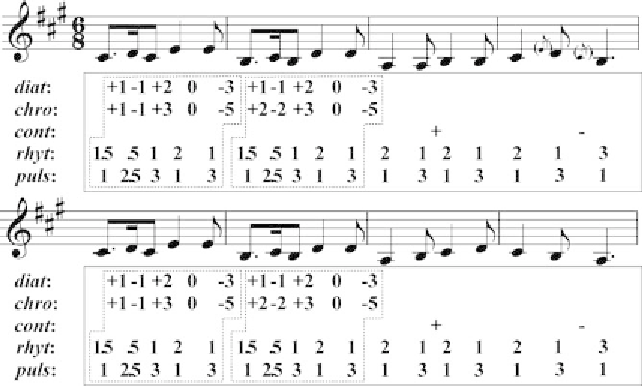Information Technology Reference
In-Depth Information
step-leap profile comprising five distinct symbols
(ascending step or leap, descending step or leap,
unison) coupled with rhythmic information. As a
further refinement of the algorithm, instances are
allowed to be members of more than one category.
For that purpose, a variant of the pattern extrac-
tion algorithm has been developed using “don't
care” symbols for elements that may belong to
two categories (Cambouropoulos, Crochemore,
Iliopoulos, Mohamed, & Sagot, 2005).
phrases that repeat the same pattern. This pattern,
enclosed in a solid box in the figure, is decomposed
into two parts: a
melodico-rhythmic
antecedent,
and a
rhythmic
consequent
3
.
Another example is the finale theme of
Beethoven's
Ninth Symphony
(Figure 7), which
begins with an antecedent/consequent repetition
of a phrase, with identities both in pitch and time
domains, except a slight modification at the end-
ing of each phrase.
Due to the very limited degree of specificity
of the gross contour parameter, patterns made
of ascendant and descendant intervals are not
easily recognised if the occurrences are too
distant in time (Dowling & Harwood, 1986). It
has been suggested, therefore, that repetition of
gross contour sequences can be identified only
when sufficiently close in time such that, when
the second occurrence is heard, the first one
remains in short-term memory. Indeed, gross
contour sequences can more easily be searched
in short-term memory due to the limited size of
the memory store, and availability of its content.
On the other hand, a search in long-term memory
adaptive matching in a
multi-parametric space
We propose a generalization of the multiple view-
point approach that allows
variability
in the set of
musical dimensions used during the construction
of each musical pattern. This enables to take into
consideration a more general type of pattern,
called
heterogeneous pattern
, which despite its
structural complexity seems to catch an important
aspect of musical structure. An example of het-
erogeneous pattern is the first theme of Mozart's
Sonata in A
, K. 331 (Fig. 6), which contains two
Figure 6. Heterogeneous motivic description of the first theme of Mozart's Sonata in A, K. 331, bars
1-8 (slightly simplified): each line repeats a same pattern, whose first half is melodico-rhythmic, and
its second half purely rhythmic.

Search WWH ::

Custom Search